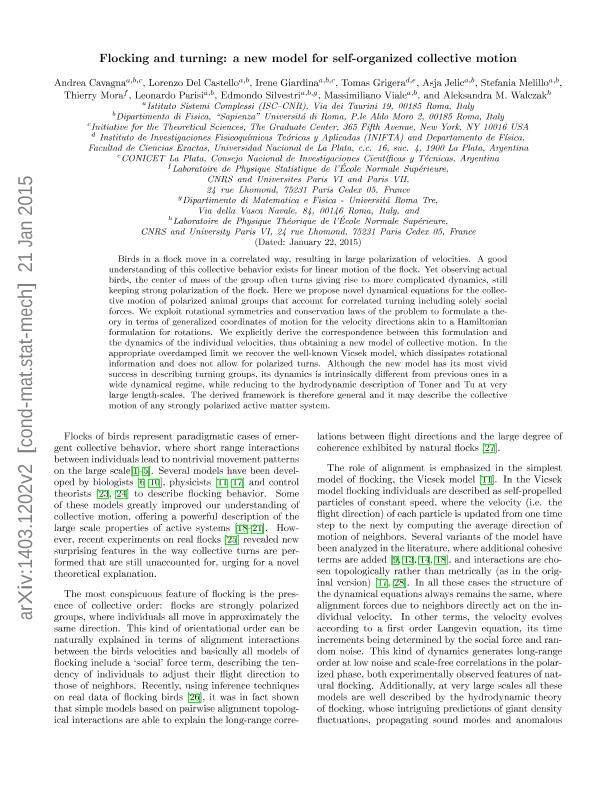Mostrar el registro sencillo del ítem
dc.contributor.author
Cavagna, Andrea
dc.contributor.author
del Castello, Lorenzo
dc.contributor.author
Giardina, Irene
dc.contributor.author
Grigera, Tomas Sebastian

dc.contributor.author
Jelic, Asja
dc.contributor.author
Melillo, Stefania
dc.contributor.author
Mora, Thierry
dc.contributor.author
Parisi, Leonardo
dc.contributor.author
Silvestri, Edmondo
dc.contributor.author
Viale, Massimiliano
dc.contributor.author
Walczak, Aleksandra M.
dc.date.available
2016-04-12T14:21:45Z
dc.date.issued
2014-09-27
dc.identifier.citation
Cavagna, Andrea; del Castello, Lorenzo; Giardina, Irene; Grigera, Tomas Sebastian; Jelic, Asja; et al.; Flocking and turning: a new model for self-organized collective motion; Springer; Journal Of Statistical Physics; 158; 3; 27-9-2014; 601-627
dc.identifier.issn
0022-4715
dc.identifier.uri
http://hdl.handle.net/11336/5143
dc.description.abstract
Birds in a flock move in a correlated way, resulting in large polarization of velocities. A good understanding of this collective behavior exists for linear motion of the flock. Yet observing actual birds, the center of mass of the group often turns giving rise to more complicated dynamics, still keeping strong polarization of the flock. Here we propose novel dynamical equations for the collective motion of polarized animal groups that account for correlated turning including solely social forces. We exploit rotational symmetries and conservation laws of the problem to formulate a theory in terms of generalized coordinates of motion for the velocity directions akin to a Hamiltonian formulation for rotations. We explicitly derive the correspondence between this formulation and the dynamics of the individual velocities, thus obtaining a new model of collective motion. In the appropriate overdamped limit we recover the well-known Vicsek model, which dissipates rotational information and does not allow for polarized turns. Although the new model has its most vivid success in describing turning groups, its dynamics is intrinsically different from previous ones in a wide dynamical regime, while reducing to the hydrodynamic description of Toner and Tu at very large length-scales. The derived framework is therefore general and it may describe the collective motion of any strongly polarized active matter system.
dc.format
application/pdf
dc.language.iso
eng
dc.publisher
Springer

dc.rights
info:eu-repo/semantics/openAccess
dc.rights.uri
https://creativecommons.org/licenses/by-nc-sa/2.5/ar/
dc.subject
Flocking
dc.subject
Active Matter
dc.subject
Collective Behavior
dc.subject
Emergent Behavior
dc.subject
Animal Groups
dc.subject.classification
Biofísica

dc.subject.classification
Ciencias Biológicas

dc.subject.classification
CIENCIAS NATURALES Y EXACTAS

dc.title
Flocking and turning: a new model for self-organized collective motion
dc.type
info:eu-repo/semantics/article
dc.type
info:ar-repo/semantics/artículo
dc.type
info:eu-repo/semantics/publishedVersion
dc.date.updated
2016-05-06 15:52:43.262787-03
dc.journal.volume
158
dc.journal.number
3
dc.journal.pagination
601-627
dc.journal.pais
Alemania

dc.journal.ciudad
Berlin
dc.conicet.avisoEditorial
The final publication is available at Springer via http://dx.doi.org/10.1007/s10955-014-1119-3
dc.description.fil
Fil: Cavagna, Andrea. Centro Nazionale di Ricerca. Istituto Sistemi Complessi; Italia. Universita Di Roma; Italia. The Graduate Center. Initiative for the Theoretical Sciences; Estados Unidos
dc.description.fil
Fil: del Castello, Lorenzo. Centro Nazionale di Ricerca. Istituto Sistemi Complessi; Italia. Universita Di Roma; Italia
dc.description.fil
Fil: Giardina, Irene. Centro Nazionale di Ricerca. Istituto Sistemi Complessi; Italia. The Graduate Center. Initiative for the Theoretical Sciences; Estados Unidos
dc.description.fil
Fil: Grigera, Tomas Sebastian. Consejo Nacional de Investigaciones Científicas y Técnicas. Centro Científico Tecnológico la Plata. Instituto de Investigaciones Fisicoquímicas Teóricas y Aplicadas; Argentina. Universidad Nacional de La Plata; Argentina
dc.description.fil
Fil: Jelic, Asja. Centro Nazionale di Ricerca. Istituto Sistemi Complessi; Italia. Universita Di Roma; Italia
dc.description.fil
Fil: Melillo, Stefania. Centro Nazionale di Ricerca. Istituto Sistemi Complessi; Italia. Universita Di Roma; Italia
dc.description.fil
Fil: Mora, Thierry. Centre National de la Recherche Scientifique. Université Paris VI; Francia
dc.description.fil
Fil: Parisi, Leonardo. Centro Nazionale di Ricerca. Istituto Sistemi Complessi; Italia. Universita Di Roma; Italia
dc.description.fil
Fil: Silvestri, Edmondo. Centro Nazionale di Ricerca. Istituto Sistemi Complessi; Italia. Universita Di Roma; Italia
dc.description.fil
Fil: Viale, Massimiliano. Centro Nazionale di Ricerca. Istituto Sistemi Complessi; Italia. Universita Di Roma; Italia
dc.description.fil
Fil: Walczak, Aleksandra M.. Centre National de la Recherche Scientifique. Université Paris VI; Francia
dc.journal.title
Journal Of Statistical Physics

dc.relation.alternativeid
info:eu-repo/semantics/altIdentifier/arxiv/1403.1202v2
dc.relation.alternativeid
info:eu-repo/semantics/altIdentifier/url/http://link.springer.com/article/10.1007%2Fs10955-014-1119-3
dc.relation.alternativeid
info:eu-repo/semantics/altIdentifier/doi/http://dx.doi.org/10.1007/s10955-014-1119-3
dc.relation.alternativeid
info:eu-repo/semantics/altIdentifier/doi/10.1007/s10955-014-1119-3
dc.relation.alternativeid
info:eu-repo/semantics/altIdentifier/url/http://arxiv.org/abs/1403.1202v2
Archivos asociados
